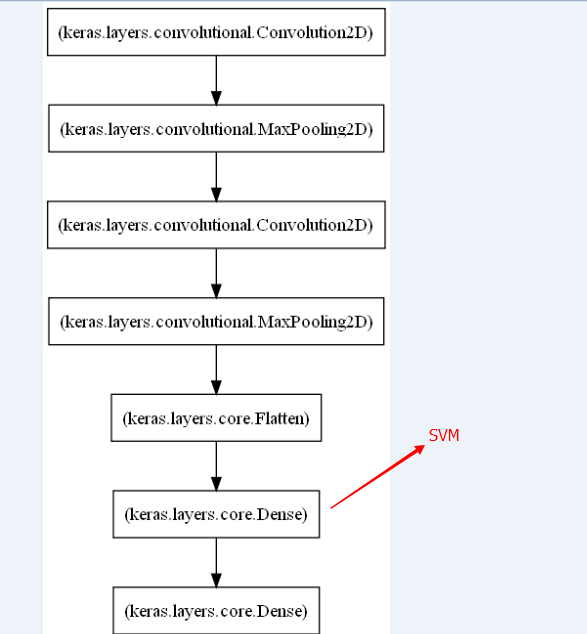版权声明:如需转载,请注明出处http://blog.csdn.net/a819825294
1.介绍
Keras是基于Theano的一个深度学习框架,它的设计参考了Torch,用Python语言编写,是一个高度模块化的神经网络库,支持GPU和CPU。keras官方文档地址 地址
2.流程
先使用CNN进行训练,利用Theano函数将CNN全连接层的值取出来,给SVM进行训练

3.结果示例
因为这里只是一个演示keras&SVM的demo,未对参数进行过多的尝试,结果一般

4.代码
由于keras文档、代码更新,目前网上很多代码都不能使用,下面贴上我的代码,可以直接运行
from keras.models import Sequential
from keras.layers.core import Dense, Dropout, Activation,Flatten
from keras.layers.convolutional import Convolution2D, MaxPooling2D
from keras.optimizers import SGD
from keras.datasets import mnist
from keras.layers import BatchNormalization
from sklearn.svm import SVC
import theano
from keras.utils import np_utils
def svc(traindata,trainlabel,testdata,testlabel):
print("Start training SVM...")
svcClf = SVC(C=1.0,kernel="rbf",cache_size=3000)
svcClf.fit(traindata,trainlabel)
pred_testlabel = svcClf.predict(testdata)
num = len(pred_testlabel)
accuracy = len([1 for i in range(num) if testlabel[i]==pred_testlabel[i]])/float(num)
print("cnn-svm Accuracy:",accuracy)
#each add as one layer
model = Sequential()
#1 .use convolution,pooling,full connection
model.add(Convolution2D(5, 3, 3,border_mode='valid',input_shape=(1, 28, 28),activation='tanh'))
model.add(MaxPooling2D(pool_size=(2, 2)))
model.add(Convolution2D(10, 3, 3,activation='tanh'))
model.add(MaxPooling2D(pool_size=(2, 2)))
model.add(Flatten())
model.add(Dense(100,activation='tanh')) #Full connection
model.add(Dense(10,activation='softmax'))
#2 .just only user full connection
# model.add(Dense(100,input_dim = 784, init='uniform',activation='tanh'))
# model.add(Dense(100,init='uniform',activation='tanh'))
# model.add(Dense(10,init='uniform',activation='softmax'))
# sgd = SGD(lr=0.2, decay=1e-6, momentum=0.9, nesterov=True)
model.compile(optimizer='sgd', loss='categorical_crossentropy')
(X_train, y_train), (X_test, y_test) = mnist.load_data()
#change data type,keras category need ont hot
#2 reshape
#X_train = X_train.reshape(X_train.shape[0],X_train.shape[1]*X_train.shape[2]) #X_train.shape[0] 60000 X_train.shape[1] 28 X_train.shape[2] 28
#1 reshape
X_train = X_train.reshape(X_train.shape[0],1,X_train.shape[1],X_train.shape[2])
Y_train = np_utils.to_categorical(y_train, 10)
#new label for svm
y_train_new = y_train[0:42000]
y_test_new = y_train[42000:]
#new train and test data
X_train_new = X_train[0:42000]
X_test = X_train[42000:]
Y_train_new = Y_train[0:42000]
Y_test = Y_train[42000:]
model.fit(X_train_new, Y_train_new, batch_size=200, nb_epoch=100,shuffle=True, verbose=1, show_accuracy=True, validation_split=0.2)
print("Validation...")
val_loss,val_accuracy = model.evaluate(X_test, Y_test, batch_size=1,show_accuracy=True)
print "val_loss: %f" %val_loss
print "val_accuracy: %f" %val_accuracy
#define theano funtion to get output of FC layer
get_feature = theano.function([model.layers[0].input],model.layers[5].get_output(train=False),allow_input_downcast=False)
FC_train_feature = get_feature(X_train_new)
FC_test_feature = get_feature(X_test)
svc(FC_train_feature,y_train_new,FC_test_feature,y_test_new)























 1450
1450

 被折叠的 条评论
为什么被折叠?
被折叠的 条评论
为什么被折叠?








